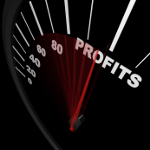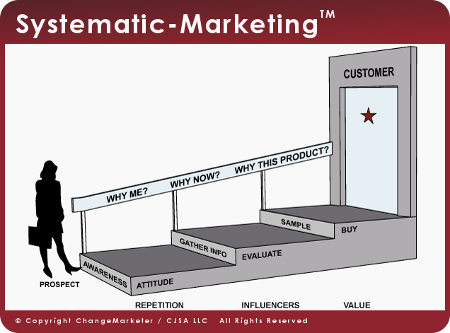Fast Track Growth and Profitability

Product launches are often linear: first make the product, second try to sell it, third try to communicate its value, and finally try to make money. If you practice Systematic-Marketing, you can fast track this process and speed profitability.
Recap
This is a thread about How to Leverage the Marketplace Forces that Matter Most for Business Growth. Eight crucial marketplace forces have been identified and are being explored in depth in this series.
What is Systematic-Marketing?
Systematic-Marketing is a process for converting prospects into buyers, cost-effectively. Think of it as a set of steps that you and the prospect climb together to reach a purchase decision. The goal is to be prepared by anticipating …
- What the prospect will need to make a purchase decision
(specifications, performance, references, etc.) - Who else will influence the buy decision
(spouse, partner, industry analyst, etc.) - How the prospect can “try-before-they-buy”
(free trial, sample, preview, etc.)
This is how you realize a payback on your marketing efforts that is cumulative, not episodic.

Marketing for a Blockbuster
A good example, that we have all experienced, of Systematic-Marketing at work is how the movie industry builds momentum for a blockbuster opening.
- Sample: The movie trailer is how you sample the product
- Influencers: The movie reviewer receives a preview
- Awareness: Interviews and advertisements that include the trailer
Don’t take the expensive step of generating large-scale awareness until you have anticipated and addressed all three steps in the buying process. A lot of time, money and frustrating false starts can be saved.
Targeting the Optimal Prospect
Let’s step through the whole process once, starting by identifying the optimal prospect to target. From ChangeMarketer’s perspective, prospects can be identified as potential, reachable, and optimal.
Potential: Those identified as having interest in your value proposition. This target market forms the largest pool of prospects that a marketer has to draw upon. However, exhibiting interest is not the same thing as having buying behavior.
Reachable: These are potential prospects that have existing marketing “highway” that reaches them. In most cases, it is difficult enough to build a new product without also having to construct the “highway” to reach potential customers.
Optimal: These are reachable prospects that have a compelling reason to buy a product like yours, now. They represent the best near-term opportunity to be converted into buyers.
To move through a buying process, you and the prospect are going to have to make an investment. Both of you are going to want to be sure that it is worth the effort.
Step One: Awareness
Generating awareness and a positive attitude towards your company, its products and its services is the first step. This is most often accomplished by repetition of a compelling message.
Awareness: Creating a concise message of your value and taking it to the prospect, speeds the “introduction” process. “Build it and they will come” only works in the movies.
Attitude: You will hear it said that there is “no such thing as bad press”. However, those who have tried to sell into a negative attitude situation would disagree. It is more difficult to sell a cruise after an iceberg “incident”.
Repetition: It is more than what you say – it is what the prospect hears. That’s why repetition works. The prospect hears more each time. Energy put into creating an initial clear message and then repeating it, pays off.
You are not alone in creating awareness, but it is you who can get the ball rolling in order to get word-of-mouth, influencers and media working for you.
Step Two: Evaluation
Once you have awareness, the prospect will typically turn to people they trust for input. Prospects never forget that you have an agenda, which is to sell them something, so they maintain a healthy amount of skepticism about your claims.
Gather Information: Prospects expect you to provide details such as technical specifications, a return on investment analysis and client references, in an easy to digest format. Interest can vanish or be diverted to a competitor at this stage.
Evaluate: Ask yourself who else can speak on your behalf? Satisfied clients, analysts/experts and the media are just a few examples. What they have to say will be more important to the prospect than what you have to say at this stage.
Influencers: You can fast track the evaluation process by anticipating who the prospect will turn to when evaluating your product, and what that influencer will need to know.
If the buying influencers are not anticipated and addressed, the investment in awareness generation is at risk.
Step Three: Purchase
Following awareness and evaluation, the prospect can then turn their attention towards making the purchase decision.
Sample: Experiencing the product for themselves is one of the most effective ways for the prospect to make a buy decision. That’s why “free trials” are so popular.
Buy: Now the costs to purchase become a hard reality. A prospect can be interested in a new car, be made aware of specific make and model that suit his or her needs, read the reviews, and even take a test-drive. However, the rubber meets the road when then time arrives for the signature and payment.
Value: To close the deal, the value/resource/reason triumvirate dominates. The value to the prospect must be clear. The resources (money, people and/or time) need to be allocated. Last but not least, a compelling reason to act now must be part of the purchase equation.
Compelling Messaging: The Prospects’ Handrail

For prospects to take these three big steps — awareness, evaluation and purchase — your messaging must be compelling. Think of messaging as the handrail that the prospects rely upon as they take each step. In previous blog posts I have described how to make your messaging compelling by focusing on answering Why Me?, Why Now? Why this Product?
Why Me?: Ask, “Who is the me I’m talking to and why should they be interested in listening to what I have to say.” You have only one chance to make a first impression. If you want to create a connection that is valued, you do it by first communicating what is in it for the other person, not the details of how your product or technology works.
Why Now? Consider “Do I have a compelling “Why Now” capable of moving people beyond interest to action?” A compelling answer to “Why Now” will rapidly propel you to your destination. Anything else leaves you without the benefit of marketplace forces.
Why This Product?: Ask yourself, “Why This Product?”, and use the ChangeMarketer Positioning Choices — Only, First, Best or Most — to help you stand out from the rest.
The Customer
If you practice Systematic-Marketing, you can fast track the process of converting prospects into customers cost effectively, and speed profitability. Realize a payback on your marketing efforts that is cumulative, not episodic.
What is Next?
The 8 Marketplace Forces countdown continues. The next post will be…
Market Force #8: Realistic Marketing Math?

